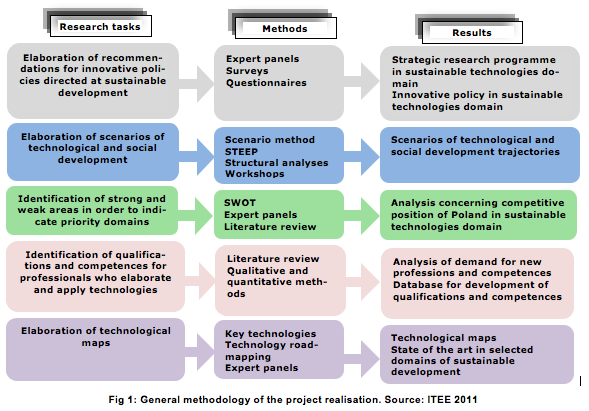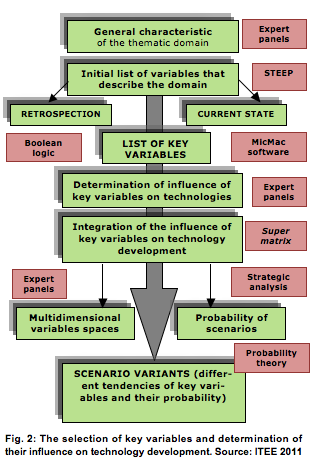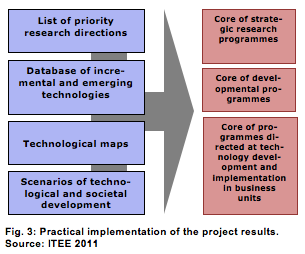The Polish technological foresight project entitled ‘Advanced Industrial and Ecological Technologies for the Sustainable Development of Poland’ was dedicated to support the development of technologies enhancing sustainable development and staff training for the generation and exploitation of advanced technologies. The main objectives were preparing proposals for a new strategic programme directed at advanced industrial and ecological technologies in Poland, identifying and promoting professional competences in the advanced industrial technologies domain, supporting investment decisions and the implementation of innovative process and product solutions, and elaborating scenarios of technological and social development geared toward sustainable development objectives with a time horizon of 2020. The project was coordinated by the Institute for Sustainable Technologies – National Research Institute in Radom, Poland (ITeE – PIB) within the European Innovative Economy Operational Programme.
Innovative Technologies Tailor-made for Polish Research and Infrastructure
It is essential to introduce long-term research programmes based on innovative technologies to deliver a more sustainable economy. Efficient technology forecasting and focusing on specific basic and applied research areas that might lead to implementing results in the field of advanced technologies are crucial to a knowledge-based economy. For the unfolding acceleration of global innovation that is expected, it is necessary to develop only the most promising areas of scientific activity and business at different organisational levels: national, regional and corporate. The development and implementation of priority technologies enhancing sustainable development will contribute to a future increase in the technological level and competitiveness of enterprises that exploit innovative solutions. Therefore, technology foresight projects have important issues to address.
The principle of sustainable development was of key importance to the National Foresight Programme ‘Poland 2020’ realised between 2007 and 2009. The outcomes of the programme included R&D priorities in the following research areas: ‘Information and Telecommunication Technologies,’ ‘Safety’ and ‘Sustainable Development of Poland.’ However, the determined R&D priorities were too general to enable scientific-research institutions, such as the Institute for Sustainable Technologies – National Research Institute, to effectively identify, sort and prioritise detailed research projects or to allow companies to make investment decisions concerning particular innovative technological solutions.
Accordingly, there was a serious need for more focus and customisation of the results of NPF ‘Poland 2020’, concerning especially the ‘Sustainable Development of Poland’ research area. That is why the Institute for Sustainable Technologies – National Research Institute has designed and undertaken a sectoral foresight project ‘Advanced Industrial and Ecological Technologies for the Sustainable Development of Poland.’
The main aim of the research within the aforesaid project was to generate promising research and development directions in the fields of manufacturing technologies, application and operation of machinery as well as environmental protection, to indicate priority technologies within the framework of selected research areas, and prepare descriptions of their characteristics and development scenarios, which was the main aim of the sectoral foresight project presented here.
The thematic scope of the project comprised the following fields:
- Advanced material technologies, nanotechnologies and technological systems supporting their design and applications.
- A special research and testing apparatus.
- Mechatronic technologies and control systems for supporting processes of manufacturing, operation and maintenance.
- Pro-ecological technologies, rationalization of the exploitation of materials and resources, and renewable sources of energy.
- Technologies of technical and environmental safety.
Moreover, the project made it possible to identify the needs concerning the knowledge and competence necessary to develop and apply new technologies as well as to develop descriptions of future jobs and the relevant qualifications. This will facilitate the preparation of recommendations with respect to new standards of professional qualifications and supplementing existing standards and provide a foundation for the development of modular programmes of education and professional training. The implementation of these programmes will contribute to the efficient organisation and carrying out of education, training, professional skills improvement and retraining designed to educate personnel for advanced industrial technologies.
Work conducted within the project included the following research tasks (Fig. 1):
- Drawing up technology maps
- Identifying qualifications and competences
- Determining strong and weak points
- Developing scenarios
- Elaborating a strategic research programme concerning sustainable development.

Scenario Development and Risk Assessment with Qualitative and Quantitative Tools
Because of the consequences of decisions, foresight should not only be based on qualitative models and expert knowledge but should also employ quantitative methods to outline measurable indicators enabling an objective and methodically justified risk assessment of technology development and investments in scientific research. Therefore, one of the main features of the proposed methodology is the integration of quantitative and quantitative approaches. The methodology was thus designed focused on three main issues that occur within the technology foresight implementation phase:
- generation of multidimensional scenarios based on key variables;
- technology prioritisation; and
- determination of probability of future scenarios.
In this brief, we concentrate on how and with what results the first main issue, identification of key variables, was tackled. The subsequent issues concerning technology prioritisation and the probability of scenarios will be discussed in subsequent articles.
The classical methodology generally used in foresight exercises enables the creation of scenarios considering only two key variables. Utilizing the experience acquired in a number of foresight projects, we have developed a methodology allowing to create much more complex future visions based on tendencies of an unlimited number of key variables. The main goal of this effort was to identify all crucial factors that might influence technology development, thus identifying options to actively shape the future. Furthermore, this knowledge about the drivers of technological change provide criteria for assessing the usefulness of new strategic programmes in the future.
The methodology for generating multidimensional scenarios used in the project was based on Boolean logic, structural analyses, and expert knowledge, which is fundamental to foresight projects. We investigated relations between important system factors and determined the ones most crucial in shaping the future system. Social, technological, economic, ecological and political factors all have an impact on technological development and were all considered accordingly in the structural analyses. We applied a cross impact analyses for the selection of key variables. For this purpose, we used the computer-aided program MIC-MAC. The classical method of performing structural analyses was modified and adjusted to the project requirements. The auxiliary techniques used in identifying the key variables were STEEP, probability theory and strategic analysis.
The algorithm illustrated in Figure 2 enables selecting key variables that significantly influence the internal and external environment of technology development.

Since the core area of the project concerns advanced technologies, scenarios and strategic plans must also include the development paths of technologies and research priorities. Therefore, the algorithm considers procedures for determining mutual influences between system drivers. Moreover, the influence of key variables on technology development is also pointed out in the Super matrix.
To go beyond traditional techniques, we adapted methods of strategic analyses to forecast technological change. We furthermore integrated into the presented algorithm the methodology of technology prioritisation and scenario building based on the probability and direction of impact that a key variable has on a certain technology. This allows determining key variables that can be deliberately influenced to achieve assumed future scenarios and realise strategic plans.
The results of these analyses, together with the results of technology prioritisation and probability assignment, were used to formulate recommendations for determining future priority research areas.
This methodology of generating multidimensional scenarios has a modular structure and can be modified in accordance with user requirements.
Project Results Used for Strategic Research Programmes at National Level
The results of the project ‘Advanced Industrial and Ecological Technologies for the Sustainable Development of Poland’ were taken into account in preparing proposals for strategic research programmes in the area of technical support of sustainable development (Fig. 3). One of those programmes, ‘Innovative Systems of Technical Support for Sustainable Development of Economy’, has been selected in a competitive process from among a number of proposals by significant national research organisations and has been granted funding through the European Union structural funds.
Moreover, the project results are not only planned to be used in preparing other future research and development programmes but also in realising cooperative endeavours with the business sector in order to implement technologies recognised as priority ones.

| Authors: | Joanna Łabędzka joanna.labedzka@itee.radom.pl
Adam Mazurkiewicz adam.mazurkiewicz@itee.radom.pl |
|||||||
| Sponsors: | Ministry of Regional Development | |||||||
| Type: | The sectoral technology foresight project | |||||||
| Organizer: | Institute for Sustainable Technologies – National Research Institute | |||||||
| Duration: | 04/2009–04/2011 | Budget: | ~ 475,000 € | Time Horizon: | 2020 | Date of Brief: | July 2011 | |
EFP Brief No. 200_Advanced Technologies in Poland
Sources & References
Arcade, J., Godet, M., Meunier, F., Roubelat, F. (1994): Structural analysis with the MICMAC method & actors’ strategy with MACTOR method, AC/UNU Millennium Project Futures Research Methodology.
Firat, K., Lee Woon, W., Madnick, S. (2008): Technological Forecasting – A Review. (Last accessed July 2011 http://web.mit.edu/smadnick/www/wp/2008-15.pdf
Gierszewska, G., Romanowska, M. (2009): Analiza strategiczna przedsiębiorstwa, PWE Warszawa, pp. 188-190.
Loveridge, D. (1995): What are scenarios for? In: Profutures Workshop, Scenario building, Convergences and differences. Workshop proceedings, Seville, European Commission, pp. 13-16.
Mazurkiewicz, A., Poteralska, B., Karsznia, W., Łabędzka, J., Sacio-Szymańska, A., Wachowicz, K. (2008): Raport z realizacji prac w ramach Panelu Pola Badawczego ”Zrównoważony rozwój Polski”, II etap realizacji prac – opracowanie scenariuszy rozwoju, ITeE-PIB, Radom, listopad.
Mazurkiewicz, A., Poteralska, B.: Zrównoważony rozwój Polski. W: Kleer, J., Wierzbicki, A. (eds.) (2009): Narodowy Program Foresight Polska 2020: Dyskusja założeń scenariuszy. Komitet Prognoz “Polska 2000 Plus” Polska Akademia Nauk, pp. 105-152.
Oniszk-Popławska, A., Monica, B., Joergensen, Birte H., Velte, D., Wehnert, T. (2003): ENER Forum 5. Technological change, market reform and climate policy, Bucharest, Romania, 16-17 October 2003 – EurEnDel.
Popper, R.: Foresight Methodology. In: Georghiou, L., Cassingena, J., Keenan, M., Miles, I. and Popper, R. (eds.) (2008): The Handbook of Technology Foresight, Concept and practice, Edward Elgar, pp. 44-88.
Mazurkiewicz, A. (ed.) (2010): Report “Scenariusze trajektorii rozwoju technologicznego i społecznego w obszarze zrównoważonego rozwoju” opracowany w ramach projektu “Zaawansowane technologie przemysłowe i ekologiczne dla zrównoważonego rozwoju kraju”, maszynopis, Instytut Technologii Eksploatacji – Państwowy Instytut Badawczy, Radom.